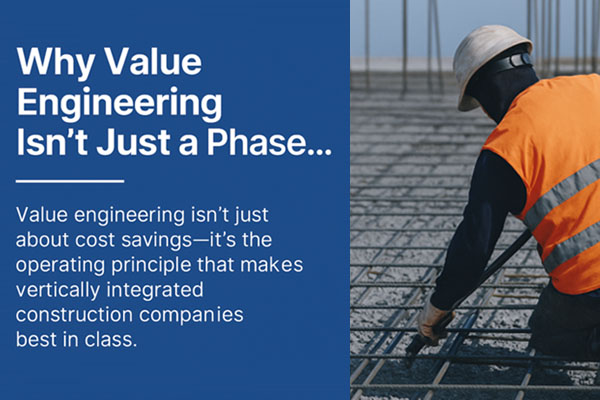Why Value Engineering Is the Backbone of the One Company – One Solution Model
In today’s construction landscape, complexity is the norm. Projects span multiple jurisdictions, design teams work in silos, supply chains are volatile, and timelines are tighter than ever.
In today’s construction landscape, complexity is the norm. Projects span multiple jurisdictions, design teams work in silos, supply chains are volatile, and timelines are tighter than ever. Yet in the middle of this pressure cooker, a growing number of construction companies are rethinking how projects are delivered – not just by changing the tools, but by changing the entire structure of how they operate.
They’re turning to the One Company – One Solution model.
This approach – where engineering, manufacturing, and construction are all performed under one roof – isn’t just about convenience. It’s about control, coordination, and value. And at the heart of it all is one powerful tool: Value Engineering (VE).
What Is Value Engineering, Really?
Let’s be clear: value engineering is not cost-cutting. It’s about delivering the same or better functionality for less waste – whether that’s cost, time, labor, or materials. It’s a structured process that asks: “How can we build this smarter without sacrificing performance or quality?”
When done right, VE improves constructability, accelerates timelines, and ensures the final product performs as intended – with fewer surprises and lower total cost of ownership.
But here’s the catch: VE loses much of its power in fragmented delivery models.

Where Traditional Models Fall Short
In most construction projects, design is done by one team, fabrication by another, and construction by yet another. These teams may never speak directly. When problems arise – say, a design that doesn’t account for fabrication limits or field conditions—the fix is expensive and often delayed.
In these models, value engineering usually shows up after problems are discovered. By then, materials are ordered, schedules are locked in, and change means cost. At best, VE becomes a reaction. At worst, it’s just a euphemism for cutting quality to meet budget.
Enter: One Company – One Solution
When engineering, manufacturing, and construction sit inside the same company, VE evolves from a reactive tool to a proactive
operating principle.
Here’s what happens when value engineering is applied within a vertically integrated structure:
Real-Time Feedback Loops
Designers and engineers don’t guess what’s buildable – they talk directly to fabrication and construction teams. Adjustments are made early, when they’re fast and inexpensive.
Design for Manufacturability and Installation
Materials, dimensions, and tolerances are optimized from day one. Drawings aren’t just pretty – they’re practical.
Controlled Cost and Schedule Alignment
With in-house pricing and production, teams don’t have to wait for third-party bids or adjust to unexpected supply issues – they can plan with certainty.
Less Waste, Fewer Errors
Redundant submittals, RFIs, and costly rework are drastically reduced. VE becomes part of the design DNA.
Greater Accountability
No finger-pointing. One company owns the entire process and is invested in every phase delivering successfully.
Where This Approach Really Shines
While the One Company – One Solution model can be applied to nearly any sector, it delivers the most powerful results in:
- Modular and prefabricated construction
- Retail rollouts and repeatable layouts
- Workforce and affordable housing developments
- Fuel station and C-store programs
- Government and public infrastructure projects
In each of these markets, speed, scale, and cost control are essential – and that’s exactly where integrated value engineering delivers the most impact.
A New Standard for the Industry
Clients are no longer satisfied with fragmented responsibility. They want single-source accountability. They want innovation backed by execution. And most of all, they want partners who understand that delivering true value means more than just hitting a low bid – it means designing with intent, building with clarity, and delivering with confidence.
The future of construction belongs to those who don’t just talk about integration – but build it into their structure.
If you’re still treating value engineering as an afterthought, or viewing it as someone else’s job, you’re missing the opportunity to
lead.
Final Thought:
Value engineering is no longer a phase. In a vertically integrated model, it’s a mindset – and a competitive advantage.
